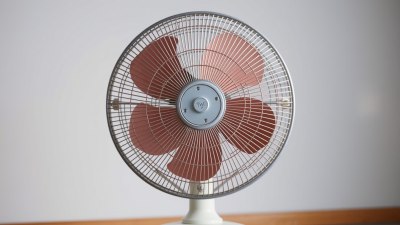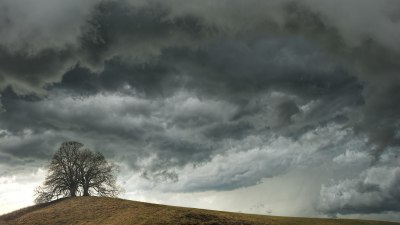How Atmospheric Pressure Influences Mood and Sleep
Explore how changes in atmospheric pressure affect human mood and sleep patterns, revealing the science behind weather and well-being.

Atmospheric pressure, also known as barometric pressure, is a fundamental aspect of Earth's weather systems, influencing everything from storm formation to temperature changes. But beyond its meteorological importance, atmospheric pressure significantly affects human physiology, particularly mood and sleep. This article delves into how fluctuations in atmospheric pressure can alter emotional states and sleep quality, combining insights from scientific research and practical observations.
Understanding Atmospheric Pressure
Atmospheric pressure is the force exerted by the weight of air in the atmosphere pressing down on the Earth's surface. It is measured in units like millibars (mb) or inches of mercury (inHg). At sea level, the average pressure is approximately 1013 millibars or 29.92 inHg. This pressure is not constant; it varies with altitude, weather patterns, and daily cycles.
High-pressure systems usually bring clear skies and stable weather, while low-pressure systems can cause clouds and precipitation. These changes influence not only the environment but also human biology. The body constantly adapts to minor environmental shifts, and atmospheric pressure is one such subtle yet impactful factor.
Physiological Effects of Atmospheric Pressure Changes
When atmospheric pressure drops during approaching storms or low-pressure weather systems, the body experiences a slight decrease in external pressure. This change may affect oxygen availability marginally, as lower pressure means fewer oxygen molecules per breath. Some people are more sensitive to this, resulting in physiological reactions such as headaches, joint pain, or fatigue.
On the other hand, high-pressure conditions can make air denser, potentially increasing oxygen intake and leading to feelings of alertness. These changes in oxygen levels and pressure can impact the nervous system, influencing the release of hormones and neurotransmitters related to mood regulation, such as serotonin and dopamine.
The Impact on Mood
Mood fluctuations linked to weather and atmospheric conditions are well documented in scientific literature. Seasonal Affective Disorder (SAD), for instance, is influenced by changes in daylight and associated atmospheric conditions, often worsening in low pressure and cloudy weather.
Research has shown that low atmospheric pressure can increase irritability, lethargy, and feelings of depression. The exact mechanisms are complex but are thought to involve multiple pathways. One pathway is the effect on serotonin levels, a neurotransmitter critical for mood stabilization. Low-pressure conditions can disrupt serotonin production or receptor function, leading to mood downturns.
Another factor is the psychological impact of weather. Low pressure often accompanies overcast skies, rain, and storms, which can reduce outdoor activities and social interaction, contributing to feelings of isolation and sadness. Conversely, high-pressure days typically have clearer skies, encouraging physical activity and social engagement, which enhance mood.
Studies involving weather-sensitive individuals confirm that mood ratings decline as barometric pressure drops. Some experiments have participants report their emotional state over days with varying pressure, consistently noting lower mood scores during low-pressure episodes.
Exploring Atmospheric Pressure and Sleep Quality
Sleep is another critical area influenced by atmospheric conditions. Although the body maintains homeostasis, external environmental factors can alter sleep initiation, depth, and duration. Atmospheric pressure changes play a subtle yet important role in this equation.
During falling pressure, some individuals experience difficulties falling asleep or maintaining deep sleep phases. This might be linked to minor disruptions in breathing caused by changes in air density and oxygen availability. For example, under low-pressure conditions, the slightly thinner air can lead to shallow breathing or heightened awakening during the night.
Moreover, atmospheric pressure changes can trigger physical discomforts such as headaches or muscle pain, which interfere with restful sleep. Additionally, the stress response induced by perceived discomfort may increase cortisol levels, a hormone known to reduce sleep quality.
Conversely, stable or high-pressure conditions are often associated with more restful and uninterrupted sleep. The improved oxygenation and absence of weather-related discomfort contribute to better sleep architecture, allowing individuals to cycle properly through the stages of sleep, especially the restorative deep sleep and REM phases.
Scientific Studies and Evidence
Numerous studies have examined the relationship between atmospheric pressure, mood, and sleep. For instance, a 2011 study published in the Journal of Affective Disorders found that patients with mood disorders experienced significant mood deterioration correlated with low barometric pressure days. The study relied on daily mood self-assessments and objective meteorological data over extended periods.
Sleep researchers have also analyzed polysomnographic data, observing shifts in sleep latency and duration relative to barometric pressure changes. Findings suggest that while atmospheric pressure is only one of many environmental factors influencing sleep, its effects are measurable and consistent in sensitive individuals.
Furthermore, a meta-analysis of weather's influence on human health underscored atmospheric pressure’s role in exacerbating migraine headaches and joint pain, which indirectly affect mood and sleep quality. These interconnected factors reveal the complex ways in which atmospheric pressure integrates into human well-being.
Practical Implications and Coping Strategies
Understanding the effects of atmospheric pressure on mood and sleep has practical value, especially for individuals sensitive to weather changes or those suffering from mood and sleep disorders. Here are several strategies to mitigate adverse effects:
- Monitoring Weather Reports: Awareness of upcoming low-pressure systems can help individuals anticipate mood or sleep disturbances and prepare accordingly.
- Maintaining a Consistent Sleep Schedule: Keeping regular sleep and wake times can stabilize circadian rhythms despite atmospheric fluctuations.
- Optimizing Sleep Environment: Ensuring a cool, dark, and quiet room supports better sleep quality and may counteract minor physical discomfort caused by atmospheric fluctuations.
- Physical Activity: Engaging in exercise during high-pressure periods boosts mood and resilience, helping offset low-pressure related declines.
- Light Therapy: For mood disorders worsened by atmospheric conditions, light therapy can simulate bright sunny conditions, improving serotonin levels and emotional state.
- Hydration and Diet: Staying hydrated and maintaining balanced nutrition supports physiological stability during environmental stress.
The Role of Individual Differences
Not everyone experiences the impact of atmospheric pressure changes equally. Genetic, physiological, and psychological factors modulate sensitivity to weather. Some individuals, such as those with migraines, arthritis, or mood disorders, report greater susceptibility to pressure changes.
Additionally, psychological attitudes towards weather can affect perception. People who feel anxious about storms or bad weather might notice stronger mood declines during low-pressure conditions. Conversely, those who enjoy rainy or cloudy weather may not experience negative mood shifts.
Age also matters; older adults might be more vulnerable to the physical effects of pressure changes, translating into mood and sleep disturbances. Conversely, younger, healthier individuals may adapt more readily.
Future Research Directions
While current research establishes a link between atmospheric pressure, mood, and sleep, further studies are necessary to understand mechanisms fully. Particularly, integrating genetic studies could clarify why some individuals are more susceptible.
Emerging wearable technologies offer opportunities to gather continuous physiological data synchronized with meteorological information. Such big data approaches may unveil personalized weather-related health profiles, enabling targeted interventions.
Moreover, exploring the interaction between atmospheric pressure and other weather components—temperature, humidity, wind—will clarify how combined environmental factors influence human well-being, paving the way for improved preventive measures.
The influence of atmospheric pressure on mood and sleep underscores the intricate relationship between humans and their environment. Even subtle changes in the pressure enveloping us can ripple through our physiology and psychology, modifying how we feel and rest.
By acknowledging these effects, individuals and health professionals can implement strategies to minimize discomfort and maintain emotional and physical balance amidst changing weather conditions. Research continues to illuminate the complexities of this relationship, promising improved understanding and management of weather-sensitive health issues in the future.











